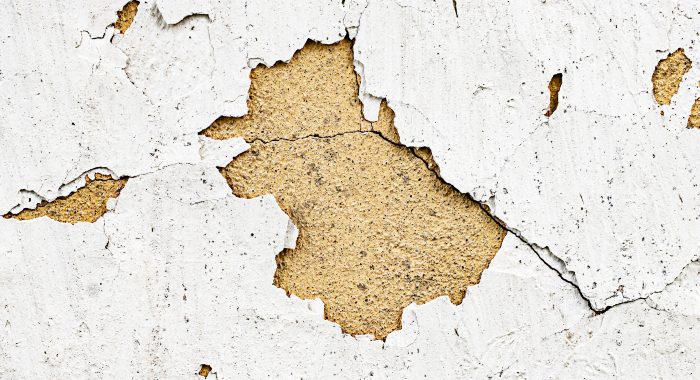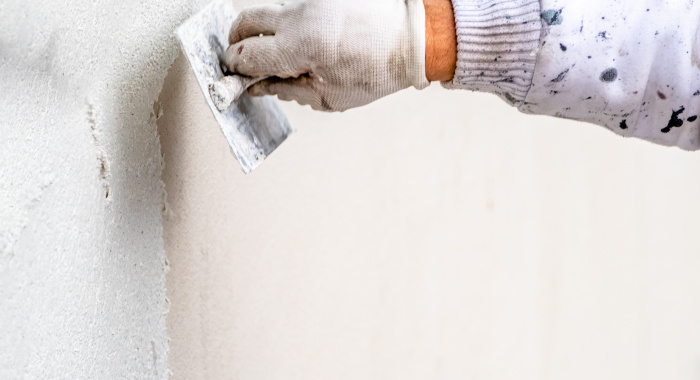Rendered walls can provide a beautiful finish to a house, making it look elegant and sleek from the outside. But one of the first rules about buying a property is that looks aren’t everything, and before you commit, you should always find out what might be hiding beneath the surface…
If you’re considering buying a house with rendered walls, make sure you undergo a thorough inspection using our guide on what to look out for before you buy.
Having bought a house with rendered walls ourselves, we use our experience to put together this article to help you make the right decision for you.
What are rendered walls?
Rendered walls are exterior walls that have a layer of plaster finish to create a smooth finish on a property. The most popular forms of rendering use the following materials:
Cement
It makes a naturally grey, flat, and smooth texture. Cement can be mixed with paint to create an array of colours.
Lime
delivers a smooth finish like cement, but with a stronger and more durable material. Usually, lime rendering is lighter in nature.
Pebble dash
It is composed of gravel, flint, and shells. Pebble dash is added to cement to create a rough, grainy appearance.
Most of the time, rendered walls are used to make properties more attractive and give them a different look than traditional brick. But there are some other benefits (and drawbacks) to rendered houses that you should be aware of if you’re thinking of buying a house with rendered walls.
The benefits of rendered walls
The most common reason rendered walls are used is to create a certain look. But besides the aesthetic, there are two big benefits to having them. These are the most popular reasons for buying a house with rendered walls.
Firstly, rendered walls create a watertight barrier, helping to protect against damp. This can be a real lifesaver in the UK! It also helps protect your property value as time goes on — if you don’t encounter any damp problems.
Secondly, rendered walls increase insulation and help improve energy efficiency by providing another layer on your house. This means you will spend less on heating to keep the house warm, saving money in the long term.
The downsides of rendered walls
The biggest drawback of buying a house with rendered walls is the expected maintenance cost. Rendered walls don’t last forever, so it will be your responsibility to ensure that the rendering is repaired and maintained over time.
The exact repair cost will depend on the materials used, with costs trending from £100 per 5m2 for a patch repair of cement to over £350 per 5m2 for more expensive materials like monocouche. If you have particular colours, it may also cost more to match the style and design of the house.
If the rendering starts to break down, you could end up with trapped moisture behind the render — leading to issues with damp or mould inside the house.
One of the advantages we previously mentioned when buying a house with rendered walls was that rendering can make the walls watertight. But the downside of this is that it can also stop the walls from being breathable.
This is an issue we encountered in our home. It was built in the 1850s with solid walls, which have been rendered. Because the rendering isn’t breathable, we had problems with condensation, that led to damp.
We tried various things, like anti-condensation paint, Wallrock thermal liner and the previous owners installed a positive pressure vent.
And while they helped, we are now looking at re-rendering the house using a new type of render. Its main feature is that it’s breathable, which should get rid of the condensation once and for all.
However, it’s not cheap. The builder has to remove the old render first, which will set us back several thousand pounds.
Top 5 things to look out for when buying a house with rendered walls
No two rendering jobs are the same. Like any part of a property, the quality and condition will vary from house to house. So it’s important that you do a thorough inspection to see if a rendered house is worth your time or a red flag.
We’ve made the process easy with our 5 things to look out for when buying a house that has rendered walls.
1. The condition of the render
Does the rendering look even, smooth, and new? Or is it starting to fall apart?
The condition of the walls is the first thing you should pay attention to when considering a house with rendering. So, take time to walk around the property and view the rendering from all angles.
Look out for any of the following:
Surface flaws
Are there any bumps, unevenness, or indentations present? These imperfections could indicate issues with the application or underlying structure.
Hollow spots
Areas where the render appears sunken in could signal trapped moisture, leading to mould growth and dampness inside the house.

Any windows overhanging the render
Not having enough window clearance can lead to moisture problems and potential damage.
Cracks
The most important thing to look out for when inspecting the condition of the render is cracks. They are your biggest red flag as they can result in the render falling off the wall in big sheets. This isn’t only hazardous but will result in an expensive repair job.
2. Damp inside the house
Correctly installed rendering should protect homes from damp. However, if there are any problems with the render, damp can get trapped between the layers of the render and the house, causing damp issues.
This is dangerous because it can cause structural issues. Damp can also severely affect your respiratory health.
If you notice any moisture or damp inside the interior walls, this might mean there’s an underlying issue with the render that needs fixing.
3. Energy rating and bills
Properties with high-quality rendering are better insulated, making them more energy efficient. If you’re thinking of investing in a house with rendered walls, make sure that you inspect the property’s energy rating and, if possible, compare the average bill prices to neighbouring properties.
If things look different than inspected, there could be underlying issues with the render.
4. Maintenance History

When inspecting a house with rendered walls, it’s also a good idea to know when the walls were rendered and last maintained. If the walls were only recently done, you won’t have to think about maintenance and repair costs for a few more years.
The lifespan of rendering depends on several factors, including the material and application quality. Modern acrylic or plastic-based renders can last 20-40 years, while traditional cement renders, which are more prone to shrinkage and cracking, last 7-15 years.
Knowing how long rendering lasts, and when it was last maintained, will give you a rough prediction of how long you have until you need to pay for further repairs.
5. Is it guaranteed?
If a wall has been rendered within the last few years, it might still be covered under a guarantee to cover any issues that might arise.
These guarantees usually last around 5-10 years and might not cover every type of damage, so always check the small print! However, they can be a useful safety net to have at your disposal if you are considering purchasing a house with a rendered wall.
Get a professional inspection for rendered walls
Carrying out a property survey is an important step for any property purchase, but especially if you are looking at buying one that has rendered walls, as it will discover the true condition of the property. If all goes well, the survey will confirm that the property is sound and help you decide to buy.
If the survey does flag anything, it will give you the information you need to know about how bad the issues are and how much work it will take to repair them.
There are different types of property surveys available, ranging from a valuation survey that simply checks whether you’re overpaying for your home to in-depth structural surveys conducted by structural engineers.
For peace of mind, we’d recommend carrying out a homebuyer’s report to check the condition of the rendering and the property and provide advice on any issues found. If there are issues, you can choose to have a more intensive survey done – or decide it’s not worth it.
Is buying a house with rendered walls worth it?
Rendered walls can make a property look beautiful. If they are applied correctly and in the best position, they can also provide some protection against damp and increase the property’s energy efficiency.
However, you must carefully inspect and check the condition of rendered walls before you buy. If they are not adequate, they could hide expensive issues and repairs that you will become liable for down the line.
In addition, you will also need to account for the costs of repair and maintenance over the years, which will give you an extra expense to account for!
Armed with the top five things to look out for, we’re sure you’ll make the best decision about whether buying a house with rendered walls is worth the cost. And before you make any big decisions, we recommend choosing a chartered surveyor to confirm there are no underlying issues hiding behind the beautiful facade…




